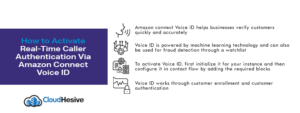Real-time caller authentication allows your call center to screen calls for added fraud security then route them and provide all the information your reps need faster than ever

Secure business strategies must encompass secure interactions. These interactions should not only hold good internally but also externally. And it goes without saying that Caller/Customer authentication is an important part of any customer security and anti-fraud strategy.
AWS’s Amazon Connect has a feature named Amazon Connect Voice ID that allows businesses to authenticate callers quickly and accurately It is backed by machine learning technology, which enables it to detect fraud using a watchlist.
Traditionally, caller verification has been done through a series of questions involving security numbers or other personal information. Amazon Connect Voice ID is a superior and cost-effective method for caller authentication because it analyzes and records the caller’s unique voice characteristics, which results in faster and more accurate caller identification that doesn’t force customers to answer a bunch of ID questions whenever they call in.
You can upgrade your interactive voice response (IVR) by adding Voice ID. This will give secure customer access to self-service requests such as changing contact information and checking refund status.
The Voice ID feature can be set up easily. The first step involves enabling Voice ID in the AWS console for your Amazon Connect instance. The second step is to configure Voice ID.
Activating Voice ID through the Amazon Connect Console
In this topic, we’ll only be mentioning stepwise instance activation of Voice ID through the console. Activating Voice ID in your Amazon Connect Console involves three steps.
1. Granting permissions
You have to ensure that you grant permissions to Identity and Access Management (IAM) users, groups, or roles. For more information on how to do this, go to this page.
2. Naming the Voice ID domain
Follow these instructions to create a new domain:
- a) Access the Amazon Connect Console via http://console.aws.amazon.com/connect.
- b) Choose the instance alias on the instance page. The alias is also your instance name, which appears in your amazon connect URL.
- c) Choose voice ID in the navigation pane. Read and accept the Biometric Privacy Act
(BIPA) consent acknowledgment. - d) Go to the Domain setup section and click on create a new domain.
- e) In the domain name section, enter the name of your organization.
3. Create an AWS Key Management Service to encrypt the data in the domain
The following instructions will help you create an AWS KMS key to encrypt data:
- a) Choose Create KMS key under the Encryption section to create your unique AWS KMS key so your voice ID domain can be encrypted.
- b) Once you hit the create KMS button, a new tab opens in your browser for the KMS console. Find the configure key page, click on Symmetric, and then click Next.
- c) Add KMS name and description on the Add Labels page and then click Next.
- d) Choose Next on the Define Key Administrative Permissions page and Define Key Usage Permissions page.
- e) Choose Finish on the Review and edit key policy page.
- f) Go back to the console browser Voice ID page. Now click on the AWS KMS key so that the key you created can appear in the dropdown list. Once you find it there, click it to choose it.
Now choose Enable Voice ID, which will activate Voice ID for your instance.
Configuring Voice ID in your contact flow
Add the required blocks in your contact flow and configure Voice ID according to your liking.
- a) Play prompt: You can edit this block by including a welcome message.
- b) Set Voice ID: This block is used to stream audio to Amazon Connect Voice ID to authenticate caller identification when the call is connected to the contact flow. This is the block where you can do configurations.
- c) Set Contact Attributes: Use this block to connect customer attributes with Voice ID.
- d) Check Voice ID: This block can be used to check the response from Voice ID for its different functions, such as enrollment, caller authentication, and fraud detection.
How does the Voice ID work?
Once enabled, Voice ID functions in two ways.
If the caller is not enrolled in the database, which is voluntary for the caller, then the Voice ID verifies the caller’s identity and records the different nuances of the voice as part of the enrollment process. There is no need for the caller to say any specific phrases for the enrollment process to complete, just opt-in to Voice ID.
If the caller is already enrolled, the Voice ID compares the enrolled person’s voice with the voiceprint already in the database and returns an authentication result.
Because Voice ID works automatically once the caller is enrolled, it dramatically speeds up caller authentication and identification. As they speak on the call, it simply verifies the voiceprint in the background.
Activate known fraudster detection
You can create a watchlist of known fraudsters by employing a registration API on the audio recordings stored in your S4 bucket. See Create and edit fraudster watchlist for more information.
When any person calls a business, Amazon Connect Voice ID analyzes the audio to calculate a risk score and outcome to notify how much the voice is similar to any of the individuals on the fraudster list.
CloudHesive is an AWS partner company that can help you with all your cloud services requirements. We have vast experience in providing quality services to AWS clients. For more information about how you can benefit from the services on offer, contact us today.



